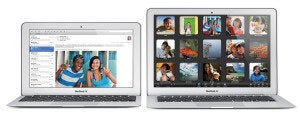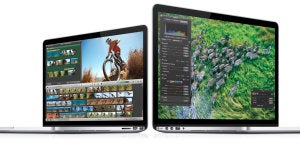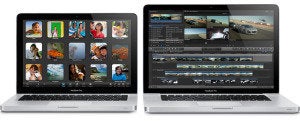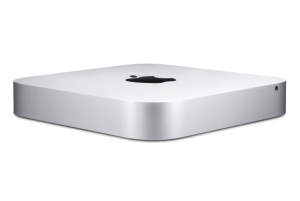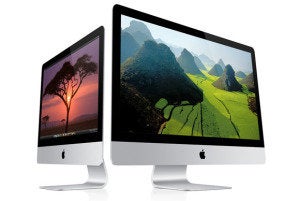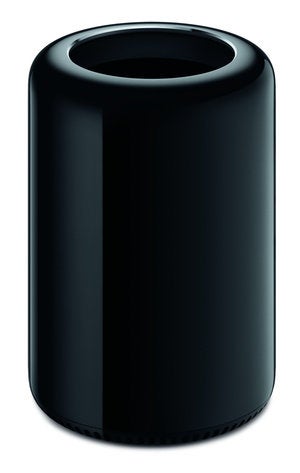This buying guide provides an overview of all the Mac models available, and what each model is best suited for.
MacBook Air
What is it? The MacBook Air is Apple’s ultrathin, ultralight laptop. It comes in two screen sizes: 11 inches (2.4 pounds) and 13 inches (3.0 pounds).
Who’s it for? The MacBook Air is ideal for anyone who is always on the go, doesn’t want to be bogged down by a regular-size laptop, and needs a computer that’s more versatile than an iPad.
What are the specifications? The four MacBook Airs have the same 1.3GHz dual-core Core i5 processor. All MacBook Air models come standard with 4GB of RAM and integrated Intel HD Graphics 5000 technology. Apple claims 9 hours of battery life for the 11-inch models, and 12 hours for the 13-inch models.
The main difference between the laptops is storage. The £849 11-inch model and the £949 13-inch model have 128GB of flash storage, while the £1029 11-inch model and the £1129 13-inch model have 256GB.
How do I connect stuff? The MacBook Air has built-in Wi-Fi for connecting to a network. It also provides built-in Bluetooth for wirelessly connecting a mouse or other peripheral. If you want to connect to an ethernet network, you'll need a USB Ethernet Adapter.
Thunderbolt is the MacBook Air’s high-speed connector. The laptop also has a pair of USB 3.0 ports, which can work with devices that use USB 2.0. If you have a FireWire 800 drive, you'll need to buy a Thunderbolt-to-FireWire Adapter.
How fast is it? The MacBook Air is quite capable of handling everyday tasks, such as sending and receiving email, browsing the Web, and using office applications. You can even use it for editing short videos, or for working with JPEGs from your iPhone or point-and-shoot camera.
The MacBook Air's flash storage really helps the performance. For example, the MacBook Air outperforms several standard configurations of the non-Retina MacBook Pro, which uses a hard drive (solid-state drives for the MacBook Pro are available for an additional cost).
Central IT's buying advice: The MacBook Air is a great laptop for someone who does general-purpose work and moves around a lot, such as a student or a self-employed person. You can’t upgrade the storage after purchase, so you should buy the model with the largest amount of storage you can afford.
MacBook Pro with Retina display
Apple sells two types of MacBook Pros. I’ll cover the Retina MacBook Pro first.
What is it? The Retina MacBook Pro features a high-density display with so many pixels that images and text look especially smooth and clean—at normal viewing distances, you can't discern individual pixels. Apple updated the Retina MacBook Pro in October.
Who’s it for? The Retina MacBook Pro is for the demanding user who wants a portable computer that also performs well. Retina MacBook Pro models sit at the top of the performance chart of Mac laptops.
What are the specifications? The Retina MacBook Pro is available in screen sizes of 13 inches and 15 inches.
There are three 13-inch models. The £1099 model has a 2.4GHz dual-core Core i5 processor, 4GB of memory, and 128GB of flash storage. The £1249 model has a 2.4GHz dual-core Core i5 processor, 8GB of memory, and 256GB of flash storage. The £1499 model has a 2.6GHz dual-core Core i5 processor, 8GB of memory, and 512GB of flash storage. All three 13-inch models have an Intel Iris Graphics integrated graphics processor.
Apple has two 15-inch Retina MacBook Pros. The £1699 model has a 2.0GHz quad-core Core i7 processor, 8GB of memory, 256GB of flash storage, and Intel Iris Pro integrated graphics. The £2199 model offers a 2.3GHz quad-core Core i7 processor, 16GB of memory, 512GB flash storage, Intel Iris Pro integrated graphics, and a discrete 2GB Nvidia GeForce GT 750M graphics processor.
The screen is the Retina MacBook Pro's marquee feature. The 13-inch Retina display has a native resolution of 2560 by 1600 pixels, and OS X offers a scaled resolution up to 1680 by 1050 pixels. The 15-inch Retina display has a native resolution of 2880 by 1800 pixels, and OS X’s highest scaled resolution on those laptops is 1920 by 1200 pixels. These high-scale resolutions can accommodate the workspace of a larger-screen standard Mac laptop on a smaller Retina MacBook Pro, if you can tolerate the smaller icons, text, and other graphics on screen. If you use a third-party app such as QuickRes, you can set the Retina screen to use resolutions higher than the scaled settings OS X offers, including the native resolution.
The Retina MacBook Pro does not have a SuperDrive, so if you need one, you'll have to buy an external USB optical drive.
How do I connect stuff? No need to worry about wireless connectivity: The Retina MacBook Pro has Wi-Fi and Bluetooth.
It’s the wired connectivity you need to be concerned with. The Retina MacBook Pro has two Thunderbolt ports, two USB 3.0 ports, an HDMI port, and that’s it. If you want to connect a FireWire device, you'll have to use a Thunderbolt-to-FireWire Adapter. Fortunately, you can use USB 2.0 devices with the USB 3.0 ports without a problem.
If you wish to connect to an ethernet network, you'll need a USB Ethernet Adapter.
How fast is it? The Retina MacBook Pro’s processors, flash storage, and 8GB of memory combine to produce impressive performance. The 15-inch models can keep up with the stock configuration of the £1149 iMac with a 2.7GHz quad-core Core i5 processor and a hard drive. Both the 13- and 15-inch Retina MacBook Pros are faster than the stock configurations of the Mac mini, Apple’s affordable desktop computer. And the Retina MacBook Pros offer a significant performance boost over their non-Retina counterpart (see below).
Interestingly, the 13-inch Retina MacBook Pro was only 10 to 15 percent faster than the 13-inch MacBook Air in much of our testing. But if your work requires a lot of heavy-duty processing, note that the MacBook Air may throttle itself down to keep its temperature at an optimal level, and such an adjustment will affect performance.
Central IT's buying advice: For the most demanding mobile Mac user—someone whose work requires a lot of processing power—the Retina MacBook Pro is the ticket. If you're looking at a 13-inch model, the £1249 Retina MacBook Pro hits a sweet spot for price and performance. The £400 that separates the two 15-inch Retina MacBook Pro models is a hefty chunk of change; the £2199 MacBook Pro is the top-of-the-line Mac laptop, offering the strongest performance. If your work mostly involves Internet access and other productivity tasks, however, go for a MacBook Air.
MacBook Pro
What is it? Before the MacBook Pro with Retina display existed, there was the MacBook Pro. This laptop has a standard, non-Retina display.
Who’s it for? The standard MacBook Pro is for the user who wants a portable computer that doesn’t sacrifice a lot. The MacBook Pro isn’t as fast as an iMac desktop system, but it can be faster than the MacBook Air at certain tasks.
What are the specifications? When Apple released the Retina MacBook Pro, the company initially kept four different models of the non-Retina MacBook Pro in stock. But when the company updated the MacBook Pro line in October, the non-Retina line was reduced to a single laptop.
That laptop is a 13-inch model with a 2.5GHz dual-core Core i5 processor, 4GB of memory, a 500GB 5400-rpm hard drive, and an integrated Intel HD Graphics 4000 graphics subsystem. You can customize your order with a faster processor, more memory, a larger hard drive, or a solid-state drive.
The standard MacBook Pro is the only Mac laptop with a built-in SuperDrive. If you need to burn or read optical discs, and you’d rather not use an external drive, the standard MacBook Pro is the laptop for you.
Apple used to offer a 17-inch standard MacBook Pro, but phased it out in favor of the 15-inch Retina MacBook Pro.
How do I connect stuff? Like all Mac computers, the standard MacBook Pro has built-in Wi-Fi and Bluetooth. But unlike other Mac laptops, the standard MacBook Pro continues to offer ports that Apple has phased out of the MacBook Air and the Retina MacBook Pro.
If you have FireWire 800 drives that you use regularly, you’ll be happy to know that the standard MacBook Pro comes with a FireWire 800 port. None of Apple’s other laptops have FireWire. If you don’t want to carry an adapter for your FireWire drive, the standard MacBook Pro is your only choice.
The standard MacBook Pro also has a gigabit ethernet port, which you can’t find on the MacBook Air and the Retina MacBook Pro.
Like all Mac laptops, the standard MacBook Pro has two USB 3.0 ports.
How fast is it? Both 13-inch standard MacBook Pro models are slower overall than the 13-inch MacBook Air—blame the performance hit on the MacBook Pro’s hard drive, which can’t keep up with the MacBook Air’s flash storage. However, the MacBook Pro has a huge performance advantage over the MacBook Air on tasks, such as video editing, that are processor intensive and don’t have to read or write to the storage device much.
Central IT's buying advice: The standard MacBook Pro is for the mobile user who doesn’t want to sacrifice a lot of features. The hard drives create a performance bottleneck, so if you want to get the best performance, consider customizing the laptop to replace the hard drive with an extra-cost SSD. If you want a laptop for travel and can’t decide between a standard MacBook Pro and a MacBook Air, go with the MacBook Air unless you really need built-in FireWire; you might also consider a Retina MacBook Pro.
Mac mini
What is it? The Mac mini is Apple’s entry-level desktop Mac. It's slower than Apple’s other desktop computers—the iMac and the Mac Pro—but it remains fast enough for general-purpose use.
Who’s it for? Apple targets first-time Mac users with the Mac mini. If you’re switching from a PC, you can use your PC’s keyboard and mouse with the Mac mini. The Mac mini is also ideal as a secondary Mac in your home, and it can integrate into your home entertainment center.
What are the specifications? What makes the Mac mini stand out is its small size. It doesn’t take up a lot of desk space.
Apple sells two Mac mini models. The £499 model has a 2.5GHz dual-core Core i5 CPU and a 5400-rpm 500GB hard drive. The £679 model includes a 2.3GHz quad-core Core i7 processor and a 5400-rpm 1TB hard drive. Both Mac minis come standard with 4GB of memory and an Intel HD Graphics 4000 graphics processor.
The Mac mini does not include a display, keyboard, or mouse, so you’ll have to provide your own—or you can customize your order to include these devices as extra-cost options.
Since the Mac mini lacks an optical drive, you need to buy an external USB optical drive if you want to read or burn CDs and DVDs.
How do I connect stuff? Like Apple’s other Macs, the Mac mini has Wi-Fi and Bluetooth. It also has four USB 3.0 ports, one Thunderbolt port, and an SDXC card slot.
The Mac mini provides a FireWire 800 port for connecting external hard drives and other devices. It also has a gigabit ethernet port, in case you want to connect to a wired network.
To connect a display, you can use the HDMI port or the Thunderbolt port. You might have to buy an adapter if your display doesn’t have either HDMI or Mini DisplayPort (which connects to the Mac mini's Thunderbolt port). If you own a display with VGA and/or DVI output, you'll need either the Mini DisplayPort-to-VGA Adapter or the Mini DisplayPort-to-DVI Adapter, which each cost £25.
How fast is it? The Mac mini won’t set any speed records—it's among the slowest Macs in Apple's lineup. But don’t judge its performance too harshly. For general use (writing, email, Web, social media) and for editing short videos, the Mac mini does just fine.
Central IT's buying advice: For new Mac users switching from a PC, the Mac mini is an excellent machine. It’s a great choice for shoppers on a budget, or for someone who wants a second computer in the home. It handles everyday usage well. If, however, you want to use a Mac as a production machine for video editing or some other task that requires substantial processing power, consider an iMac.
iMac
What is it? The iMac is Apple’s iconic all-in-one computer. Made of aluminum, the iMac has a built-in display and looks stately as it sits on a desk. It also offers top-notch performance.
Who’s it for? The iMac is great for both novices and demanding users. It can handle general-purpose and heavy-duty tasks equally well. It’s ideal for someone who needs to buy a complete computer setup (keyboard, mouse or trackpad, and display) and wants to maximize workspace efficiency.
What are the specifications? Four iMac models are currently available. Two of them have 21.5-inch displays, while the other two have 27-inch displays. All iMacs come standard with 8GB of memory and a 1TB hard drive.
The 21.5-inch £1149 iMac has a 2.7GHz quad-core Core i5 processor and Intel Iris Pro integrated graphics. The 21.5-inch £1299 iMac includes a 2.9GHz quad-core Core i5 processor and a discrete Nvidia GeForce GT 750M graphics processor with 1GB of video memory. The hard drives in the 21.5-inch iMac models are 5400-rpm drives.
You can’t upgrade the 21.5-inch iMac after you buy it, so consider paying an extra £160 at the outset for a memory upgrade to 16GB. The 21.5-inch iMac also offers a 1TB Fusion Drive upgrade for £160, a flash storage upgrade to 256GB for £160 or to 512GB for £400, and a 3.1GHz quad-core Core i7 processor upgrade for £160. The £1149 model doesn’t have a processor upgrade.
The 27-inch £1599 iMac carries a 3.2GHz quad-core Core i5 processor and a discrete Nvidia GeForce GT 755M graphics processor with 1GB of video memory. The £1749 iMac has a 3.4GHz quad-core Core i5 processor and a discrete Nvidia GeForce GTX 775MX graphics processor with 2GB of video memory. The hard drives in the 27-inch iMac models are 7200-rpm drives. Both 27-inch models offer Fusion Drive or flash storage upgrades. Another option for the £1449 model is an upgrade to a 3.5GHz quad-core Core i7 CPU for £160.
You can upgrade the RAM on the 27-inch iMac easily. The machine has four RAM slots, accessible through the back. Apple installs the standard 8GB as a pair of 4GB memory modules, so you can add more RAM after you buy the system. Or if you prefer, you can upgrade the RAM at the point of purchase to 16GB (£160) or 32GB (£480).
The iMac comes with Apple’s Wireless Keyboard and Magic Mouse. If you order online from the Apple Store, however, you can switch the keyboard to a wired version with a numeric keypad, and switch the mouse to an Apple Mouse or a Magic Trackpad, for no extra fee. You can opt to get both a Magic Mouse and a Magic Trackpad for $69 extra.
The iMac does not have an optical drive. If you want to read or burn CDs and DVDs, you need to buy an external USB optical drive.
How do I connect stuff? Wi-Fi and Bluetooth are built-in. All iMacs have four USB 3.0 ports, two Thunderbolt ports (not Thunderbolt 2), a gigabit ethernet port, and an SDXC card slot.
If you want to connect a FireWire device, you'll need to use a Thunderbolt-to-FireWire Adapter. USB 2.0 devices can connect to the iMac’s USB 3.0 ports.
How fast is it? The iMacs are among Apple’s fastest computers, but their hard drives are a performance bottleneck. If you can upgrade to a Fusion Drive or to flash storage, you'll gain a significant performance boost. The £1149 iMac's graphics performance is good enough for games, but the discrete graphics in the other iMacs are much faster.
Macworld’s buying advice: For new Mac owners, the £1149 iMac is a good alternative to the Mac mini, providing a nice performance increase. If performance is your top priority, consider a Fusion Drive upgrade, or even a faster-processor option. On a 21.5-inch iMac, the 8GB of RAM should be fine; but buying the RAM upgrade at the point of purchase could help you avoid some hassle in the future. The 27-inch iMacs are ideal for demanding users who need as much speed as they can get.
If you already have an iMac that’s less than three years old, the new iMac may be a harder sell. You’ll see a performance boost, but you’ll sacrifice some features, such as the SuperDrive.
Mac Pro
What is it? The Mac Pro is Apple’s workstation. It’s designed for professionals who need a powerful and flexible machine.
Who’s it for? The Mac Pro is ideal for professionals who work with applications that use as many processing cores as possible—video-editing applications, image-editing software, 3D programs, and the like.
What's the catch? Depending on when you read this, the new Mac Pro may not be available yet. In June, Apple revealed a new form factor for the Mac Pro; and in October, Apple said that the new Mac Pro would go on sale in December. When in December? The company didn't say. It's possible that the new Mac Pro won't be available until after Christmas.
What are the specifications? You'll find two standard-configuration models. The £2499 Mac Pro has a 3.7GHz quad-core Xeon E5 processor, 12GB of memory, and dual AMD FirePro D300 graphics processors with 2GB of video memory. The £3299 Mac Pro provides a 2.5GHz six-core Xeon E5 processor, 16GB of memory, and dual AMD FirePro D500 graphics processors with 3GB of video memory. Both models include 256GB of flash storage.
The Mac Pro offers buyers some appealing build-to-order options. You can add up to 64GB of memory, upgrade to 512GB or 1TB of flash storage, upgrade the graphics, or upgrade the processor (to a 12-core CPU).
How do I connect stuff? Unlike the previous Mac Pro, the new Mac Pro has no internal options for connecting PCI expansion cards or internal storage drives. The new Mac Pro relies on its six external Thunderbolt 2 ports for add-ons. If you have an old Mac Pro tower and PCI cards and/or drives that you want to use, you'll need to buy a Thunderbolt expansion chassis for the cards and external cases for the drives.
Wi-Fi and Bluetooth come built-in on the new Mac Pro. The machine has four USB 3 ports, dual gigabit ethernet jacks, and HDMI. Audio professionals should know that the Mac Pro has a combined optical digital audio input and analog output minijack. The computer doesn't have FireWire connections.
How fast is it? At this writing, the new Mac Pro hasn't yet shipped, so Macworld Lab hasn't tested it. Undoubtedly the new Mac Pro will be the fastest Mac in Apple's lineup, but how much of a boost will it offer over the top-of-the-line iMac?
Apple says that the new Mac Pro is a "video editing powerhouse" capable of handling 4K video editing, that 3D applications will see "ultrafast rendering," and on and on.
Central IT's buying advice: If you really, really want to buy a new Mac Pro, you'll just have to wait. Carefully consider what you plan to do with the machine. If you are doing professional work and require extreme processing capability, the Mac Pro will serve you well. If you’re a power user who doesn't need expansion capability, consider choosing an iMac or a Retina MacBook Pro instead.


